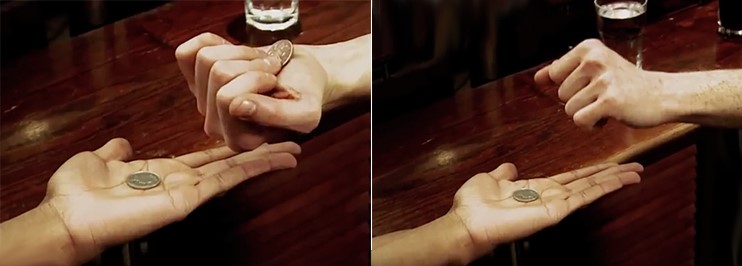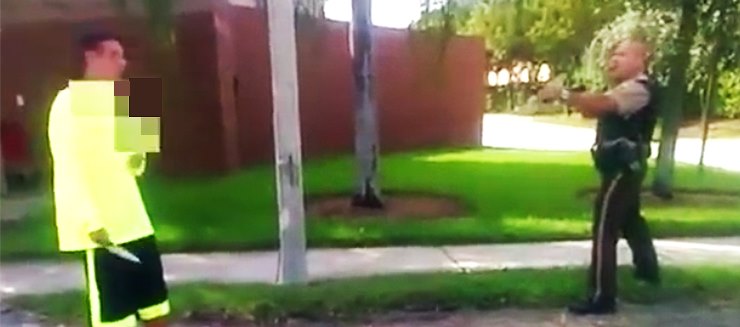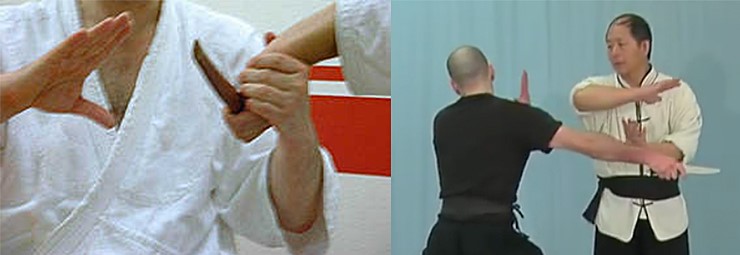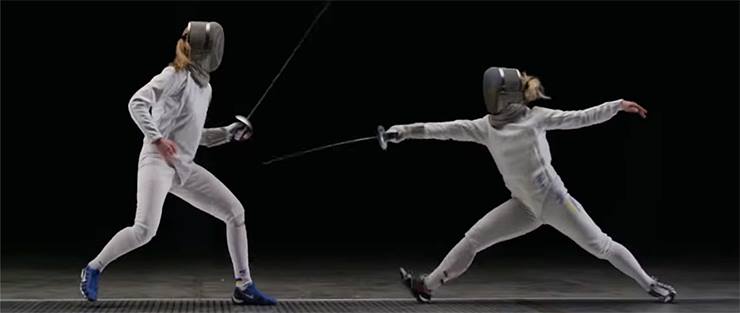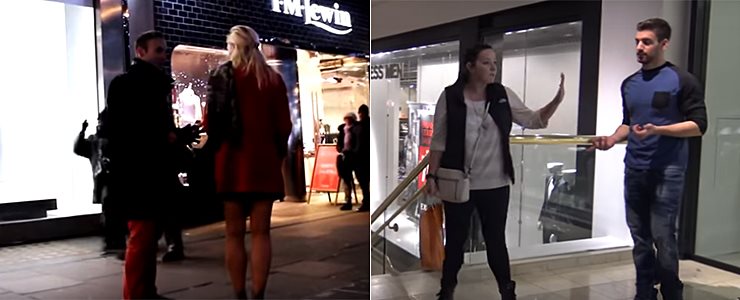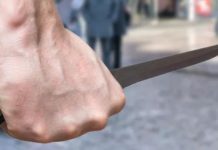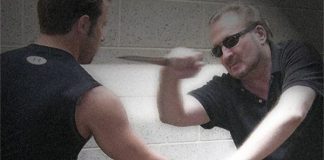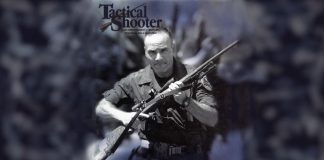I recall reading an article years ago where Bruce Lee took a coin out of someones open hand and replaced it with another coin before the participant could close his hand. At the time this was attributed to Bruce Lee’s incredible speed – or was it really? Today we all know it as the “change-over pass” a sort of utility magic trick that is based on the concept of the “reactionary gap.” This coin-snatch trick is something anyone can perform with enough practice.
The “reactionary gap” is premised upon the fact that reaction is always slower than action. In effect, when reacting to a stimulus there is a lag-time involved because the brain needs to process the stimulus before it can respond. The “gap” refers to the minimum amount of distance needed to ensure that you can safely protect yourself against the physical threat, for example a knife attack.
We’ve all heard stories about champion fighters being knocked out by someone with lessor skills, civilians being effortlessly head-butted in a club, and police officers stabbed before they could draw their firearm. The common denominator in all these cases was that the victim was unable to react in time – because he was too close.
Reaction Times
Reaction time is called the speed of neural transmission. But not everyones reaction time is the same, the average reaction time for most humans from a distance of 30.6 cm (12”) Is:
Visual Stimulus 0.25 seconds
Auditory Stimulus 0.17
Touch Stimulus 0.15
Reaction times in knife defense will differ slightly with distance, but the good news is many individuals can improve their reaction times with practice. The research into reaction times was initially done by Dennis Tueller, a Utah police officer. In 1983 he wrote an article for SWAT Magazine called “How Close is too Close?” Before that time the FBI and most law enforcement agencies usually followed a policy of – “to be close, is to be in control.” The very opposite of the way they work today.
Essentially the “Tueller Drill” (AKA the “21-Foot Rule),” has become the general (but debatable) theory that examines how far away a potential attacker with a knife can be for a police officer to be able to draw his handgun and fire. There is still a lot of confusion about the subject but the link below provides a more comprehensive explanation.
The Gap Depends on Who You Are
So why does it take so long for a police officer to draw their firearm and respond to a knife wielding attacker? Police have to validate their reason for shooting a suspect. To get a “good shoot” they need to go through the I.M.O.P. process first. I.M.O.P. stands for: Intent, Means, Opportunity and Preclusion. If they don’t meet these criteria they can be legally liable. Add to that effects of stress, startle response and adrenaline rush.
Fortunately civilian’s trained in knife defense don’t have to go through the same I.M.O.P. process so their defensive response can be quicker over a shorter distance. For a detailed explanation of I.M.O.P. see the link below:
I.M.O.P. Principle—Intent, Means, Opportunity and Preclusion
So Why Isn’t the Reactionary Gap Taught Formerly?
I’ve never personally met any martial arts instructor or student who has
been formerly taught the reactionary gap. I have known people who have masted it: most probably instinctively or through experience but have never heard it mentioned. This bewilders me since measure is the most important concepts in any type of fighting.
How Self-Defense is Taught
Many self-defense instructors come from either traditional martial arts or combatives, and Instruction is usually taught in a classroom setting.
To be cognizant about the reactionary gap, it’s necessary to develop a keen sense of situational awareness. This doesn’t happen in a martial arts venue, it’s not needed. In classrooms students practice drills to master techniques and spar in a safe environment. If someone gets hurt, the fight is immediately stopped. Knife defenses in the majority of traditional martial art classes are highly unrealistic (if taught at all).
With combatives i.e. CQC (close quarter combat) There is an element of knife training, quite often it’s too simplistic and not on par with some SE Asian Styles. Many instructors take the word “close” (from CQC) too literally, while extreme close up knife drills may work in a class scenario it’s very difficult to pull it off on the street.
The Realities of Knife Attacks on the Street
Knife attacks on the street are dangerous and can induce serious injuries or death. Quite often your defensive movements will not be sharp and clear, they may be slower due to the startle reaction and adrenalin rush. You can’t count on anyone to help you, there are
no referees, and bystanders will more likely to take videos of your beatdown – and police won’t arrive in time.
I learned about the reactionary gap when I studied fencing, all of the footwork in fencing is literally based on keeping proper measure. The footwork includes: the half advance, the full advance, the lunge, forward crossover, the step lunge and ballestra. Some parts of retreating footwork is the opposite version of going forward. In the Olympics, the fastest moving object is the marksman’s bullet. The second fastest is the tip of the fencer’s blade.
Practical Knife Defense Observations for Trained Civilians
Two common types of overt knife attacks are: 1) The fully committed attack and, 2) psycho multiple random strike attack. Both types are deadly, however the committed attack can be deflected with training, the wild and crazy psycho attack should optimally always be deflected with a shield or a quick sprint in the opposite direction. I prefer to use a shield at all times in preference to empty hands. I usually carry a soft attache case with me for this purpose.
Since the key element is to establish a safe protective distance from any physical attack, our goal is to be consistently vigilant. We can’t always choose the distances between us and strangers when we walk in public.
In NYC for example, strangers often pass us within a few inches. You can however monitor the general baseline in the environment – notice what’s normal, and what’s not.
Precautions
Most street attacks are sudden and surprising, you probably won’t get to your weapon in time. Situational awareness is key. Stay away from unsafe spaces, be attentive, watch your six, yes, people are attacked from behind. Profile everyone. Is there someone acting odd and out of place, are they staring at you, are they hiding their face, mumbling to themselves? Profiling will enable you to prepare for most attacks and focus on a plan. Profiling can lesson the effects of the startle response and adrenaline rush.
Some Types of Knife Attacks
The Interview
Robberies
Rape Attempts
Rush Attack (Close)
Rush Attack (Far)
Transitional Spaces
In and Out Attacks
The Interview
The interview is when a criminal is not sure about you and wants to determine if you are a soft or hard target. It will probably occur in a uncrowded area. They will approach you from a normal distance and may tell you they know you from college or work, or ask for directions (they may have an associate close-by). If you represent yourself as a soft target – they might just attack you.
The Distance You Need to Deflect a Close-Up Knife Attack
An average size male attacker of 5’-10,” – taking a large step forward from point zero can easily cover 3 feet. Add another 30” if he extends his arm/hand holding a folder, he has now moved forward towards you a total of 5’-6”. If he suddenly lunges at you, or is taller, or uses a kitchen knife he can easily move forward 6’ stabbing you.
It’s not realistic to step back 6’+ every time a stranger asks you for directions, however, I make it a habit of taking two steps back at an angle (I know it looks strange but I don’t care) At this point I am about 5’ away and will have a chance to deflect the primary attack.
Tips & Tricks
- The shoulder that is slightly back is the side that will attack
- Always prepare your ready “hand” positions near your chest
- Expect that the hand that is coming at you is holding a knife
- From peripheral vision, scan his feet for forward movements
- Never follow his hands, they’re too fast, look at the shoulders
- Breathe deeply – anxiety/stress can cause shallow breathing
Next Article – Part 2 / Coming Soon!
The Importance of Pre-Conflict Skills for Knife Defense – Part 2 Lessoning the FX of The Startle Response and Adrenaline Rush
We will also explore additional types of knife attacks – what to expect and how to counter them.


